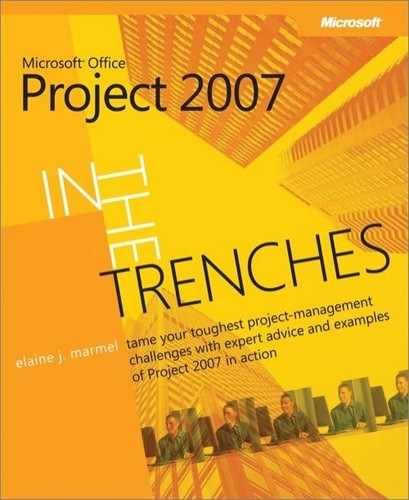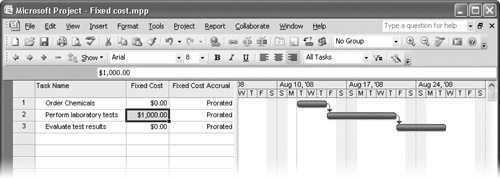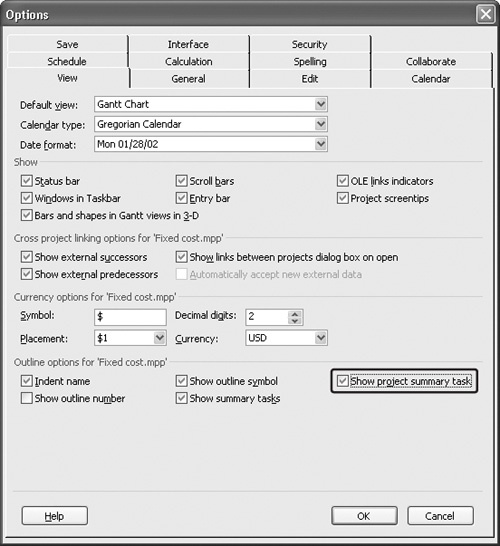In many cases, the costs you define for Work and Material resources on the Resource Sheet are sufficient. In some cases, however, you need more flexibility. Suppose that your project involves printing brochures, and there’s a $50 fee each time you set up the press to print along with the per-copy cost. Or suppose you need to rent a van for a day to transport tools from one location to another, and the van rental fee is a flat $19.95 for the day (it’s probably an old used van, but since it runs and you only need it for the day, you don’t care). And then there’s the issue of determining when Project assigns costs to your tasks. In this section, we’ll explore assigning a cost per use to a resource, adding fixed costs to a project or task, and setting cost accrual methods.
See Also
Because Cost resources are really their own breed, you can find more information about them in 7.
Suppose that a particular medical procedure requires the use of a particular instrument. The instrument costs $100 per hour to use, but there’s a calibration fee of $500 to use the instrument. The instrument would be a Work resource (remember, you can’t assign "per hour" rates to a Material resource) with an associated cost of $100 per hour plus a Cost Per Use fee of $500.
If you hire a consultant who charges you a fixed price to perform a task, regardless of the amount of work or the time involved in doing the work, you can set up the consultant as a Work resource with no hourly rate in the Std. Rate column; instead, supply the fixed price of the consultant in the Cost/Use column. This approach allows you to assign a cost to a task without affecting its duration. In addition, you can at some future time change the resource’s rate or availability, and Project will factor in the change.
Establishing a cost per use is a simple matter; supply the value in the Cost/Use column on the Resource Sheet view. But can you establish different costs per use for a resource? Yes, you can, using the technique described in 7.
Fixed costs are typically single costs you add to a task or a project to account for some charge that doesn’t depend on a resource. For example, suppose that one task in your project involves testing three chemicals for their reactions under certain conditions, and your own laboratory is very busy and can’t schedule the tests in a timely fashion. You make some calls and find out that you can hire the services of an outside laboratory to do the job when you need it done for $1,000, and delaying the project to use your own lab will force other resources to sit around and do nothing, costing your project about $1,500 in lost time. So you hire the outside laboratory for a fee of $1,000. You set up a Perform Laboratory Tests task in your project to account for the time needed to perform the tests, but you don’t need to assign any of your own resources to it. To account for the $1,000 cost of the task, you add a fixed cost to the Perform Laboratory Tests task.
Warning
Suppose that you hire a consultant who charges you a fixed price to perform a task; you might be tempted to account for the consultant’s cost as a fixed cost assigned to the task. But if you use this approach and the consultant’s availability or rate changes partway through the task, you won’t be able to account for the change. Instead, for this scenario use the Cost Per Use approach described in the preceding section.
To assign a fixed cost to a task, follow these steps:
On the View menu, click Gantt Chart to display your project in the Gantt Chart view.
Right-click the Select All button and click Cost. Project displays the Cost table of the Gantt Chart:
Select the task to which you want to assign the fixed cost.
Type the amount of the cost in the Fixed Cost column.
Note
You can assign only one fixed cost to a task. If you need to assign multiple fixed costs to a task, consider using Cost resources as described in the next section.
You can assign a fixed cost to your entire project. You might use this approach if your organization tells you to account for overhead costs for your project using a lump sum number that they supply. To assign a fixed cost to your entire project, select the Project Summary task in Step 3 above. If you don’t see the Project Summary task, on the Tools menu, click Options to display the Options dialog box shown in 3-3. Click the View tab, select the Show Project Summary Task check box, and click OK.
The way you accrue costs controls the timing Project uses to apply costs to your tasks. Although accruing costs differently won’t change the overall cost of your project, the accrual method you choose can make your project seem to be over or under budget at any particular point in time.
By default, Project accrues the cost of each resource by prorating the cost—distributing it evenly—over the life of the task to which you assigned the resource. You can opt, however, to have Project calculate the cost of the resource at the beginning or the end of the task. For example, if the month-long Create Report task culminates in producing 50 copies of the report, you might want to accrue the cost of the copier—a Material resource—at the end of the task, since that’s when you’ll actually use it.
To change the timing Project uses to accrue the cost of a resource, use the Resource Sheet view (on the View menu, click Resource Sheet). For the resource for which you want to change the timing of cost accrual, click the Accrue At field. Project displays a list box arrow; click it to display your choices and make a selection (see 3-4).
Figure 3-4. Use the Accrue At column to change the timing Project uses to accrue costs for a resource.
Be aware that Project uses the accrual timing you select for a resource for every task to which you assign the resource. So if you use that copier throughout another task, you might want to create two versions of the copier so that you can accrue its costs in two different ways.



